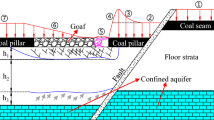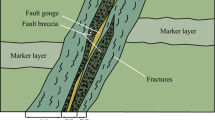Abstract
Mechanical models were used to analyze the failure depth of faulted and faultless mine floors based on the limit equilibrium theory of rock mass. In addition, the failure characteristics and water-inrush pathways were numerically investigated. The results were then compared, along with in-situ observations to validate these models. The mining-induced failure zone (an asymmetric “inverted saddle” shape) near the mined-out area was larger in the floor strata beneath the area around the coalface than that near the open-off cut. The maximum fault-induced failure depth was approximately twice that of the intact floor, which was generally equivalent to the in-situ observations. Three characteristic zones in the floor strata were observed during the mining process in the numerical models: a mining-induced failure area, a water-impervious area, and a fault reactivation area. The formation of the failure zone can be roughly divided into an initial stage, a stable stage, and a mutation stage. This study provides an improved understanding for predicting fault-induced mine water-inrushes.
Zusammenfassung
Beim Kohleabbau über Grundwasserleitern besteht die Gefahr, dass Grundwasser durch Störungen eindringt. Mit Hilfe mechanischer Modelle wurde die Versagenstiefe von gestörtem und ungestörtem Liegend auf der Grundlage der Grenzgleichgewichtstheorie des Gebirges analysiert. Zusätzlich wurden die Versagens-Charakteristika und die Wassereinbruchswege numerisch untersucht. Die Ergebnisse wurden dann mit In-situ-Beobachtungen verglichen, um diese Modelle zu validieren. Die bergbauinduzierte Versagenszone (eine asymmetrische "umgekehrte Sattel"-Form) in der Nähe des abgebauten Bereichs war in den Liegendschichten unterhalb des Bereichs um die Ortsbrust größer als im angrenzenden Alten Mann. Die maximale störungsbedingte Versagenstiefe war etwa doppelt so groß wie die Mächtigkeit des intakten Liegend, was im Allgemeinen den in-situ-Beobachtungen entsprach. Im numerisch modellierten Abbauprozess wurden drei charakteristische Zonen in den Liegendschichten beobachtet: ein bergbauinduzierter Versagensbereich, ein wasserundurchlässiger Bereich und ein Bereich der Störungsreaktivierung. Die Bildung der Versagenszone kann grob in drei Phasen unterteilt werden: eine Anfangsphase, eine stabile Phase und eine Mutationsphase. Diese Studie liefert ein verbessertes Verständnis für die Vorhersage von störungsinduzierten Grubenwassereinbrüchen.
Resumen
Existe el riesgo de que las aguas subterráneas inunden a través de fallas cuando la extracción de carbón sobre los acuíferos. Se utilizaron modelos mecánicos para analizar la profundidad de las fallas de los suelos de las minas con o sin fallas, basándose en la teoría del equilibrio límite de la masa rocosa. Además, se investigaron numéricamente las características de las fallas y las vías de irrupción de agua. Los resultados y las observaciones in situ se usaron para validar estos modelos. La zona de fallo inducido por la minería (una forma asimétrica de "silla invertida") cerca de la zona extraída era mayor en los estratos del suelo bajo el área alrededor de la cara de trabajo. La profundidad máxima de la falla inducida por la mina era aproximadamente el doble de la del suelo intacto, lo que en general equivalía a las observaciones in situ. En los modelos numéricos se observaron tres zonas características en los estratos del suelo durante el proceso de explotación minera: una zona de fallo inducido por la minería; una zona de impermeabilización y una zona de reactivación de la falla. La formación de la zona de falla puede dividirse a grandes rasgos en tres etapas: una etapa inicial, una etapa estable y una etapa de mutación. Este estudio proporciona una mejor comprensión para predecir las irrupciones de agua en la mina inducidas por fallas.
抽象
含水层上采煤存在地下水通过断裂突水风险。依据岩体极限平衡理论, 用力学模型分析了有断层和无断层底板的破坏深度。利用数值法研究了底板破坏特征和突水通道。与现场观测结果对比, 验证了模型。工作面下方的采空区底板破坏区(非对称的 "倒马鞍 "形)比切眼附近更大。断层引起的底板最大破坏深度约是完整底板的两倍, 后者总体与现场观测结果一致。在数值模型内, 底板在开采过程中有三个特征区: 开采诱发破坏区、不透水区和断层再活化区。底板破坏区的形成大致分三个阶段: 初始阶段、稳定阶段和突变阶段。研究有助于更好预测断层诱发矿井突水。








Similar content being viewed by others
References
Bai HB, Ma D, Chen ZQ (2013) Mechanical behavior of groundwater seepage in karst collapse pillars. Eng Geol 164:101–106
Biswas A, Sharma SP (2017) Geophysical surveys for identifying source and pathways of subsurface water inflow at the Bangur chromite mine, Odisha, India. Nat Hazards 88(2):947–964
Bu WK, Xu H (2020) Research on the effect of dip angle on shear stress on normal fault plane and water inrush in floor strata during mining activities. Geotech Geol Eng 38(5):4407–4421
Du WS, Jiang YD, Ma ZQ, Jiao ZH (2017) Assessment of water inrush and factor sensitivity analysis in an amalgamated coal mine in China. Arab J Geosci 10(21):471
Hu Y, Sun J, Liu WQ, Wei DY (2019) The evolution and prevention of water inrush due to fault activation at working face no. ii 632 in the Hengyuan coal mine. Mine Water Environ 38(1):93–103
Itasca Consulting Group, Inc. (2005) Fast Lagrangian analysis of continua in 3 dimensions, version 3.0, user’s manual. Itasca Consulting Group, Inc.
Li BY (1999) “Down three zones” in the prediction of water inrush from coalbed floor aquifer: theory, development and application. J Shandong Inst Min Tech 18(4):11–18 (in Chinese)
Li GY, Zhou W (2006) Impact of karst water on coal mining in north China. Environ Geol 49(3):449–457
Li LC, Yang TH, Liang ZZ, Zhu WC, Tang CA (2011) Numerical investigation of groundwater outbursts near faults in underground coal mines. Int J Coal Geol 85(3–4):276–288
Li WP, Liu Y, Qiao W, Zhao CX, Yang DD, Guo QC (2018) An improved vulnerability assessment model for floor water bursting from a confined aquifer based on the water inrush coefficient method. Mine Water Environ 37(1):196–204
Liang ZZ, Song WC, Liu WT (2020) Theoretical models for simulating the failure range and stability of inclined floor strata induced by mining and hydraulic pressure. Int J Rock Mech Min Sci 132:104382
Lu YL, Wang LG (2013) Modeling and microseismic monitoring of damage and failure evolution of faulty coal seam floor. J Min Safety Eng 30(1):38–44 (in Chinese)
Lu YL, Wang LG (2015) Numerical simulation of mining-induced fracture evolution and water flow in coal seam floor above a confined aquifer. Comput Geotech 67:157–171
Qian ZW, Huang Z, Song JG (2018) A case study of water inrush incident through fault zone in China and the corresponding treatment measures. Arab J Geosci 11(14):381
Shao JL, Zhou F, Sun WB (2019) Evolution model of seepage characteristics in the process of water inrush in faults. Geofluids 10:1–14
Shen MR, Chen JF (2006) Mechanics of rock masses. Tongji University Publishing House, Shanghai (in Chinese)
Shi LQ, Qiu M, Wang Y, Qu XY, Liu TH (2019) Evaluation of water inrush from underlying aquifers by using a modified water-inrush coefficient model and water-inrush index model: a case study in Feicheng coalfield, China. Hydrogeol J 27(6):2105–2119
Song WC, Liang ZZ, Liu WT, Zhao CB (2019) Theoretical analysis and experimental investigation on failure characteristics and stability of stope floor. Chin J Rock Mech Eng 38(11):2208–2218 (in Chinese)
Sun J, Wang LG (2013) Floor fault water-inrush prediction based on catastrophe analysis of micro-seismic signals. J China Coal Society 38(8):102–108 (in Chinese)
Sun J, Wang LG, Hu Y (2019a) Mechanical criteria and sensitivity analysis of water inrush through a mining fault above confined aquifers. Arab J Geosci 12(1):4
Sun WB, Xue YC, Li TT, Liu WW (2019b) Multi-field coupling of water inrush channel formation in a deep mine with a buried fault. Mine Water Environ 38(3):528–535
Tang CA, Tham LG, Lee PKK, Yang TH, Li LC (2002) Coupled analysis of flow, stress and damage (FSD) in rock failure. Int J Rock Mech Min Sci 39(4):477–489
Wang JA, Park HD (2003) Coal mining above a confined aquifer. Int J Rock Mech Min Sci 40(4):537–551
Wang X, Yuan W, Yan YT, Zhang X (2020) Scale effect of mechanical properties of jointed rock mass: a numerical study based on particle flow code. Geomech Eng 21(3):259–268
Wu Q, Zhou WF (2008) Prediction of groundwater inrush into coal mines from aquifers underlying the coal seams in China: vulnerability index method and its construction. Environ Geol Water Sci 56(2):245–254
Wu Q, Wang M, Wu X (2004) Investigations of groundwater bursting into coal mine seam floors from fault zones. Int J Rock Mech Min Sci 41(4):557–571
Yang TH, Liu J, Zhu WC, Elsworth D, Tham LG, Tang CA (2007) A coupled flow-stress-damage model for groundwater outbursts from an underlying aquifer into mining excavations. Int J Rock Mech Min Sci 44(1):87–97
Yin S, Zhang J, Liu D (2015) A study of mine water inrushes by measurements of in situ stress and rock failures. Nat Hazards 79(3):1961–1979
Zhai JH, Liu DL, Li G, Wang FT (2019) Floor failure evolution mechanism for a fully mechanized longwall mining face above a confined aquifer. Adv Civ Eng 2019:1–11
Zhang JC (2005) Investigations of water inrushes from aquifers under coal seams. Int J Rock Mech Min Sci 42(3):350–360
Zhang JC, Shen BH (2004) Coal mining under aquifers in china: a case study. Int J Rock Mech Min Sci 41(4):629–639
Zhang JC, Zhang YZ, Liu TQ (1997) Seepage of rock mass and water inrush from coal seam floor. Geological Publishing House, Beijing (in Chinese)
Zhang R, Jiang ZQ, Zhou HY, Yang CW, Xiao SJ (2014) Groundwater outbursts from faults above a confined aquifer in the coal mining. Nat Hazards 71(3):1861–1872
Zhang SC, Guo WJ, Li YY, Sun WB, Yin DW (2017) Experimental simulation of fault water inrush channel evolution in a coal mine floor. Mine Water Environ 36(3):443–451
Zhao JH, Zhang XG, Jiang N, Yin LM, Guo WJ (2020) Porosity zoning characteristics of fault floor under fluid-solid coupling. B Eng Geol Environ 79(5):2529–2541
Zhu WC, Wei CH (2011) Numerical simulation on mining-induced water inrushes related to geologic structures using a damage-based hydromechanical model. Environ Earth Sci 62(1):43–54
Zhu B, Wu Q, Yang JW, Cui T (2014) Study of pore pressure change during mining and its application on water inrush prevention: a numerical simulation case in Zhaogezhuang coalmine, China. Environ Earth Sci 71(5):2115–2132
Zhu GL, Zhang WQ, Wang SL, Zhang PS (2018) Experimental research on characteristics of fault activation and confined water rising. Geotech Geol Eng 36(4):2625–2636
Acknowledgements
Mr. Wang Jianning provided great assistance with in-situ observations and data processing and Mrs. Wu Na provided constructive suggestions on the paper’s framework. This study was supported by the National Natural Science Foundation of China (41977219, 51779031) and the Open Fund of State Key Laboratory of Coal Resources and Safe Mining (Grant SKLCRSMI9KFA02).
Author information
Authors and Affiliations
Corresponding author
Rights and permissions
About this article
Cite this article
Liang, Z., Song, W. Theoretical and Numerical Investigations of the Failure Characteristics of a Faulted Coal Mine Floor Above a Confined Aquifer. Mine Water Environ 40, 456–465 (2021). https://doi.org/10.1007/s10230-021-00780-4
Received:
Accepted:
Published:
Issue Date:
DOI: https://doi.org/10.1007/s10230-021-00780-4




